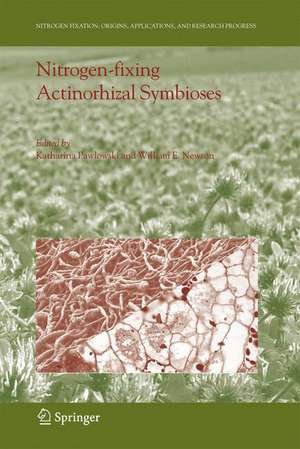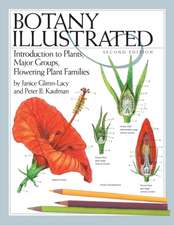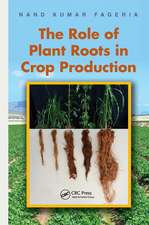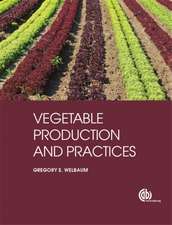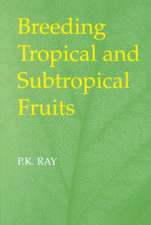Nitrogen-fixing Actinorhizal Symbioses: Nitrogen Fixation: Origins, Applications, and Research Progress, cartea 6
Editat de Katharina Pawlowski, William E. Newtonen Limba Engleză Hardback – 15 oct 2007
| Toate formatele și edițiile | Preț | Express |
|---|---|---|
| Paperback (1) | 946.24 lei 6-8 săpt. | |
| SPRINGER NETHERLANDS – 19 noi 2010 | 946.24 lei 6-8 săpt. | |
| Hardback (1) | 953.65 lei 6-8 săpt. | |
| SPRINGER NETHERLANDS – 15 oct 2007 | 953.65 lei 6-8 săpt. |
Preț: 953.65 lei
Preț vechi: 1162.99 lei
-18% Nou
Puncte Express: 1430
Preț estimativ în valută:
182.48€ • 190.52$ • 151.03£
182.48€ • 190.52$ • 151.03£
Carte tipărită la comandă
Livrare economică 04-18 aprilie
Preluare comenzi: 021 569.72.76
Specificații
ISBN-13: 9781402035401
ISBN-10: 1402035403
Pagini: 332
Ilustrații: XX, 312 p.
Dimensiuni: 155 x 235 x 19 mm
Greutate: 0.68 kg
Ediția:2008
Editura: SPRINGER NETHERLANDS
Colecția Springer
Seria Nitrogen Fixation: Origins, Applications, and Research Progress
Locul publicării:Dordrecht, Netherlands
ISBN-10: 1402035403
Pagini: 332
Ilustrații: XX, 312 p.
Dimensiuni: 155 x 235 x 19 mm
Greutate: 0.68 kg
Ediția:2008
Editura: SPRINGER NETHERLANDS
Colecția Springer
Seria Nitrogen Fixation: Origins, Applications, and Research Progress
Locul publicării:Dordrecht, Netherlands
Public țintă
ResearchCuprins
Preface to the Series, Preface, List of Contributors, Dedication.
1. Frankia and Actinorhizal Plants: A Historical Perspective: C. T. Wheeler, A. D. L. Akkermans, and A. M. Berry
1. Introduction
2. The Early Years
3. Two Decades to the New Millennium
4. Perspectives
References
2. Polyphasic Taxonomy of the Genus Frankia: D. Hahn
1. Introduction
2. Polyphasic Taxonomy Approach
3. 16S-rRNA Sequence Data
4. DNA-DNA Relatedness
5. 23S-rRNA Sequence Data
6. Genomic Fingerprinting
7. Conclusions
References
3. Frankia Ecology: M. Valdés
1. Introduction
2. Frankia as a Soil Microorganism
3. Abiotic Soil Factors and Frankia Populations
4. Biotic Soil Factors: Mycorrhizal Fungi and Frankia
5. Conclusions References
4. Evolution of Actinorhizal Host Plants and Frankia Endosymbionts: S. M. Swensen and D. R. Benson
1. Introduction
2. Host-Plant Systematics and Phylogeny
3. Frankia Phylogeny and Evolution
4. Host-Frankia Interactions and Evolution
5. Future Directions
References
5. Oxygen Responses, Hemoglobin, and the Structure and Function of Vesicles: W. B. Silvester, R. H. Berg, C.R. Schwintzer and J. D. Tjepkema
1. Introduction
2. Vesicle Structure and Oxygen Responses of Frankia in vitro
3. Responses in Symbiosis
4. Hemoglobins in Actinorhizal Nodules and Frankia
5. Concluding Discussion
References
6. Early Interactions, Infection and Nodulation in Actinorhizal Symbiosis: L. G. Wall and A. M. Berry
1. Introduction
2. Early Interactions
3. Rhizosphere Colonization
4. Root Infection by Frankia
5. Nodule Development
6. Regulation of Nodulation
References
7. Carbon and Nitrogen Metabolism in ActinorhizalNodules: C. Valverde and K. Huss-Danell
1. Introduction
2. The Actinorhizal Nodule
3. Studying C and N Metabolism of Nodules
4. Carbon Supply to Nodules
5. Carbon Uptake and Metabolism by Symbiotic Frankia
6. Nitrogen Metabolism
7. The Regulation of N Assimilation
8. ProspectsReferences
8. Ecology of Actinorhizal Plants: J. O. Dawson
1. Importance of Actinorhizal Plants
2. Occurrence and Distribution of Actinorhizal Plant Taxa and their microsymbionts
3. Ecological Factors Influencing Infective Frankia Populations
4. Ecological of Actinorhizal Plants
References
9. Molecular Biology of Actinorhizal Symbioses: L. Laplaze, S. Svistoonoff, C. Santi, F, Auguy, C. Franche and D. Bogusz
1. Introduction
2. Infection Process
3. Nodule Development
4. Nodule Functioning
5. Evolutionary Origin of Symbiotic Genes
6. Future Trends
7. Conclusions
References
10. Comparison between Actinorhizal and Legume Symbiosis: K. Pawlowski and J. I. Sprent
1. Introduction
2. Nodule Structure
3. Nodule-Induction Mechanisms
4. Host Specificity
5. Root Nodules and Other Root Symbioses
6. Evolution of Root-Nodule Symbioses
References
11. Prospects for the Study of a Ubiquitous Actinomycete, Frankia, and Its Host Plants: P. Normand and B. C. Mullin
1. Introduction
2. Development and Use of Molecular Tools for Genetic Analysis of Symbiosis
3. Prospects for Future Utilization of Actinorhizal Plants
4. Questions Still to be Addressed
5. Prospects for Extending Symbioses beyond Current Host Range
6. Conclusions
References
Subject Index
1. Frankia and Actinorhizal Plants: A Historical Perspective: C. T. Wheeler, A. D. L. Akkermans, and A. M. Berry
1. Introduction
2. The Early Years
3. Two Decades to the New Millennium
4. Perspectives
References
2. Polyphasic Taxonomy of the Genus Frankia: D. Hahn
1. Introduction
2. Polyphasic Taxonomy Approach
3. 16S-rRNA Sequence Data
4. DNA-DNA Relatedness
5. 23S-rRNA Sequence Data
6. Genomic Fingerprinting
7. Conclusions
References
3. Frankia Ecology: M. Valdés
1. Introduction
2. Frankia as a Soil Microorganism
3. Abiotic Soil Factors and Frankia Populations
4. Biotic Soil Factors: Mycorrhizal Fungi and Frankia
5. Conclusions References
4. Evolution of Actinorhizal Host Plants and Frankia Endosymbionts: S. M. Swensen and D. R. Benson
1. Introduction
2. Host-Plant Systematics and Phylogeny
3. Frankia Phylogeny and Evolution
4. Host-Frankia Interactions and Evolution
5. Future Directions
References
5. Oxygen Responses, Hemoglobin, and the Structure and Function of Vesicles: W. B. Silvester, R. H. Berg, C.R. Schwintzer and J. D. Tjepkema
1. Introduction
2. Vesicle Structure and Oxygen Responses of Frankia in vitro
3. Responses in Symbiosis
4. Hemoglobins in Actinorhizal Nodules and Frankia
5. Concluding Discussion
References
6. Early Interactions, Infection and Nodulation in Actinorhizal Symbiosis: L. G. Wall and A. M. Berry
1. Introduction
2. Early Interactions
3. Rhizosphere Colonization
4. Root Infection by Frankia
5. Nodule Development
6. Regulation of Nodulation
References
7. Carbon and Nitrogen Metabolism in ActinorhizalNodules: C. Valverde and K. Huss-Danell
1. Introduction
2. The Actinorhizal Nodule
3. Studying C and N Metabolism of Nodules
4. Carbon Supply to Nodules
5. Carbon Uptake and Metabolism by Symbiotic Frankia
6. Nitrogen Metabolism
7. The Regulation of N Assimilation
8. ProspectsReferences
8. Ecology of Actinorhizal Plants: J. O. Dawson
1. Importance of Actinorhizal Plants
2. Occurrence and Distribution of Actinorhizal Plant Taxa and their microsymbionts
3. Ecological Factors Influencing Infective Frankia Populations
4. Ecological of Actinorhizal Plants
References
9. Molecular Biology of Actinorhizal Symbioses: L. Laplaze, S. Svistoonoff, C. Santi, F, Auguy, C. Franche and D. Bogusz
1. Introduction
2. Infection Process
3. Nodule Development
4. Nodule Functioning
5. Evolutionary Origin of Symbiotic Genes
6. Future Trends
7. Conclusions
References
10. Comparison between Actinorhizal and Legume Symbiosis: K. Pawlowski and J. I. Sprent
1. Introduction
2. Nodule Structure
3. Nodule-Induction Mechanisms
4. Host Specificity
5. Root Nodules and Other Root Symbioses
6. Evolution of Root-Nodule Symbioses
References
11. Prospects for the Study of a Ubiquitous Actinomycete, Frankia, and Its Host Plants: P. Normand and B. C. Mullin
1. Introduction
2. Development and Use of Molecular Tools for Genetic Analysis of Symbiosis
3. Prospects for Future Utilization of Actinorhizal Plants
4. Questions Still to be Addressed
5. Prospects for Extending Symbioses beyond Current Host Range
6. Conclusions
References
Subject Index
Textul de pe ultima copertă
This book is the self-contained sixth volume of a comprehensive series on nitrogen fixation. It presents the state-of-the-art in regards to actinorhizal symbioses. Like legumes, actinorhizal plants form root nodules that host nitrogen-fixing soil bacteria. However, because the macrosymbionts are, with one exception, woody plants rather than crop plants, actinorhizal symbioses are less well-known than legume symbioses to which they are phylogenetically related. Actinorhizal plants come from eight different families. They can grow on marginal soils by virtue of these symbioses and are used extensively in reforestation, soil reclamation, and desert agroforestry. The diversity of the involved host plants poses a variety of challenges to the actinorhizal symbiosis and results in interesting strategies, for example, to cope with the O2 dilemma or nutrient exchange between plant and bacterium. The actinorhizal micro-symbionts are Gram-positive actinomycetes of the genus Frankia. The inability to culture several actinorhizal microsymbionts has led to the development of diverse molecular strategies for strain identification. This volume includes chapters that deal with all these aspects of the symbiosis and both symbionts plus their ecological role and use. Other chapters tackle the global distribution of different actinorhizal plants and their microsymbionts and how this impacts the question of co-evolution of the micro- and macrosymbionts as well as comparing the actinorhizal and leguminous symbioses. No other book provides the up-to-date and in-depth coverage of this volume, which is intended to serve as an indispensable reference work for academic, governmental, and industrial scientists working in this area, to introduce students to the global importance of this association, and to provide science administrators with ready access to vital relevant information.
Caracteristici
Presents state-of-the-art information in regards to actinorhizal symbioses Includes chapters dealing with all aspects of the symbiosis and both symbionts plus their ecological role and use Discusses the global distribution of different actinorhizal plants and their microsymbionts Reference work for academic, governmental and industrial scientists Volume provides science administrators with a ready access to vital relevant information
